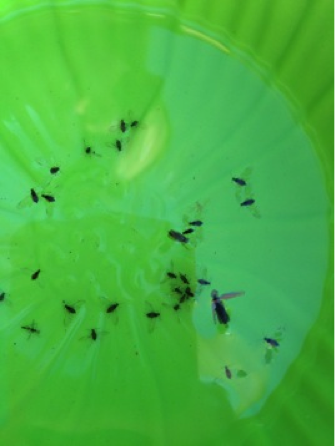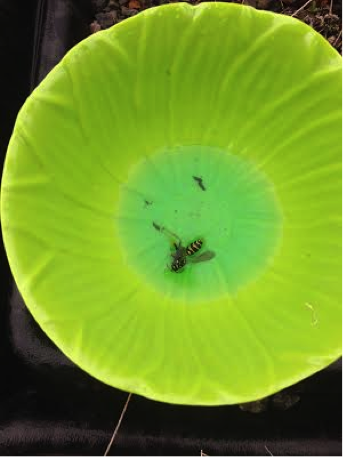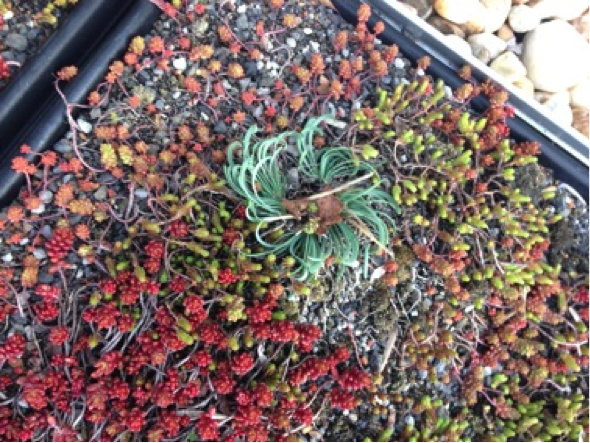Our second week of sampling proved to be slightly more exciting than the first! One morning we went onto the hospital roof, our control roof, and found 28 gnats and one fly in our brightly colored bee bowls filled with soapy water. This was the first time we collected any insects so we were very pleased with this result. This was definitely an interesting discovery because these were all found on the one non-green roof we were sampling. One theory that may explain this is that the hospital roof was actually warmer than the green roofs we studied due to the vents along the exterior walls.
On the very last day of sampling we found two more gnats, another fly, and a yellow jacket on the Rouss-Robertson roof. These were our first and only insects collected on the green roofs we were sampling this semester.
It is interesting to note that all of these insects were also found in the bee bowls. Throughout the entirety of our project, we did not collect any insects in the malaise trap or sweep nets. As the plants were still in a more dormant stage and temperatures were pretty low, there were not very many insects just flying around on the rooftops and it makes sense that we did not catch anything in the sweep nets. Using sweep nets in the summer would probably prove to be more effective as I think the warmer weather and fully-grown plants would attract more insects.
Throughout the second half of our sampling, we continued to find the Malaise trap collapsed after somewhat windy nights. It is not surprising that we kept finding it collapsed on the roof as it is relatively flimsy tent and unprotected against the wind at least three stories above the ground. Other groups monitoring green roofs have had success using the Malaise trap, so we may need to reevaluate how we secure it. For this sampling period we were using the stakes that came with the tent and two bricks to secure the tent. Perhaps in the future we should try to secure it differently.
Unfortunately, we were unable to secure a list of all the plants on the green roofs we studied before the end of our project. It could be interesting to take a look at the various species used to see if they are native or non-native. If they are non-native, perhaps that is part of the reason they were not attracting the insects we were hoping to see?
Despite the aforementioned issues that we encountered, we believe this has been a great learning opportunity that should be continued over the summer and next semester as well. With the chilly spring weather we had anticipated lower catch rates, but had clearly underestimated the lack of insects this time of year. Summertime sampling should not be an issue in this way. As for the Malaise Trap, weighing it down was not our issue. Each time it blew over, the stakes and bricks were still anchoring the bottom edges of the tent to the roof. A tall stake placed inside the tent vertically (anchored into the ground but reaching all the way to the top of the tent to hold it up) is one potential solution to safeguard the trap against wind. Now that the logistics of getting permission and safety harnesses has been taken care of, next spring’s class could start making a sampling schedule with UVA Facilities Management earlier in the semester. This way, a tentative schedule with everyone’s availability could be drafted then changed according to when warm days are in the forecast. The summer’s sampling team will have to report how much better weather improved results and reevaluate any further improvements to our methods from there.
Post by Jennifer White and Amanda Askew, Fourth-Years, Environmental Science




